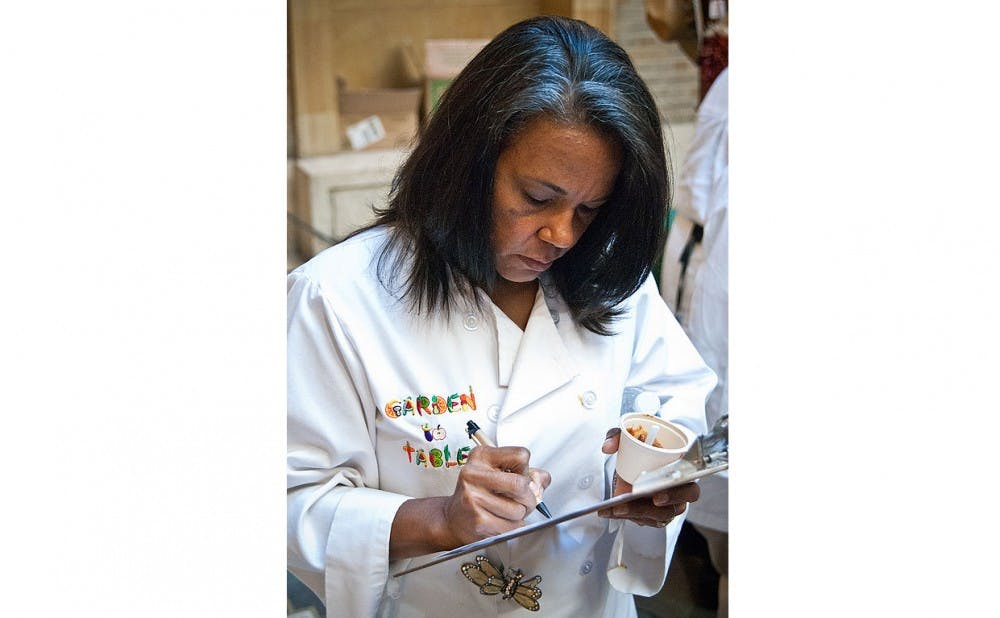In the Juanita Kreps and Lyndhurst Galleries at the Center for Documentary Studies, large black and white photos are suspended from the ceilings. Illuminated by the warm lights in the galleries, the faces of African American women from generations past came into focus. They were the former slaves, forgotten servants and aspiring young chefs who sustained American families for the last 200 years.
Curated by food and nutrition journalist Toni Tipton-Martin, "The Jemima Code" is a traveling exhibit currently housed at the CDS until Nov. 23. Through the photos of Alvin Langdon Coburn, Tipton-Martin tells the story of real African American cooks who have been trapped by the stereotype of Aunt Jemima. This caricature is an overweight, subservient and asexual servant gladly caring for her master’s family while disregarding her own children.
As defined by Tipton-Martin, “'The Jemima Code' is a 200-year-old practice of using the image of the plantation mammy to symbolize and misrepresent the knowledge, skills and abilities of African American cooks.”
Originally used to promote her book by the same name, “The Jemima Code” consists of a visual portion and an interactive one. The first is curated by Tipton-Martin and the second by Courtney Reid-Eaton, the exhibitions director at CDS. In the first room, viewers are physically able to walk around, toward and beside the women in the gallery. In this way, Tipton-Martin hopes to convey a sense of intimacy and connection that would have been impossible had the portraits been placed against the walls. Affectionately called “The Ladies” by Tipton-Martin and her readers, the larger-than-life portraits hanging from the ceilings evoke different emotions from different people.
“For some of us she brings warm memories of someone who cared for the family," Tipton-Martin said. "She might be someone who cared for you in your mother’s absence. She might be someone that you're a little ashamed of because if you're African American and you're a woman, she comes out of an era when black women were told you can’t be anything else except a domestic servant.”
“This room really connects the stereotype [of Aunt Jemima] and the history of it in different points of entry to these women," said Tamika Galanis, who works for Eaton-Reid as an intern, about the interactive part of the exhibit. "If you were to just experience that side of the exhibit with the photographs, there’s no direct representation of the typical Jemima."
The second half of the exhibit invites visitors to explore and touch the world inhabited by Tipton-Martin’s ladies. Resting on one table, nestled in a wooden box are old recipes that people can copy onto index cards to take home. On another, a variety of fragrant spices beg to be opened and smelled. Further physical manifestations of the mammy stereotype are on display, from contemporary food packaging to an Aunt Jemima cookie jar. Those interested in learning more about the issue may browse booklets with additional information and watch the movie “Ethnic Notions,” which plays on the far wall.
In addition, Tipton-Martin’s beautifully illustrated book helps to dismantle the Jemima Code and gives voice to the women whose stories have been overshadowed by racism. “The Jemima Code: Two Centuries of African American Cookbooks” is a collection of cookbooks mostly written by African American women.
“Each one of the authors and books is given their own platform and their own space of beauty,” Tipton-Martin said.
By incorporating anecdotes and portraits of the authors, readers see these women as the unique and varied individuals they were. They had their own lives and defied the plantation mammy stereotype. Overcoming the limits society placed on them, they were entrepreneurs and businesswomen who used food and cooking to advance themselves economically and socially.
“These women were not just servants…these people developed the framework of food in this country and they were professionals. They weren't just somebody’s cook, somebody’s wet-nurse, somebody’s nanny…food service…was a way that some of these women found freedom,” Galanis said.
Like Rebecca West, who graces the cover of the book, the women of “The Jemima Code” were skilled professionals in the food industry with immense pride in their work. But in an effort to dismiss the real culinary knowledge and intelligence African American chefs possessed, white people from the Reconstruction and Jim Crowe eras often attributed a cook’s proficiency in the kitchen to natural instinct and supernatural magic.
By honoring the women who contradicted the Jemima stereotype, Tipton-Martin hopes people can embrace their gifts of dignity and strength.
Get The Chronicle straight to your inbox
Signup for our weekly newsletter. Cancel at any time.

